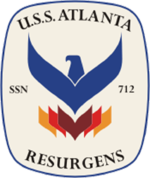
USS Texas (DLGN/CGN-39) was the United States Navy's second Virginia-class nuclear guided missile cruiser. She was the third ship of the Navy to be named in honor of the State of Texas. Her keel was laid down on 18 August 1973, at Newport News, Virginia, by the Newport News Shipbuilding and Drydock Company.

USS Virginia (CGN-38) was a nuclear-powered guided missile cruiser, the lead ship of her class, and the eighth ship of the United States Navy to be named for the Commonwealth of Virginia. She was commissioned in 1976 and decommissioned in 1994.

USS Long Beach (CLGN-160/CGN-160/CGN-9) was a nuclear-powered guided missile cruiser in the United States Navy and the world's first nuclear-powered surface combatant. She was the third Navy ship named after the city of Long Beach, California.

USS Sand Lance (SSN-660), a Sturgeon-class attack submarine, was the second ship and the second submarine of the United States Navy to be named for the sand lance, a member of the family Ammodytidae.

USS Arkansas (CGN-41) was a Virginia-class nuclear-propelled guided-missile cruiser of the U.S. Navy. She was in commission from October 1980 through July 1998. Her primary missions were in defending aircraft carrier task forces in air defense (AAW) and antisubmarine warfare (ASW) by using her guided missiles, radar systems, and sonar systems. Since Arkansas had the high speed and unlimited range provided by her nuclear reactors, she usually escorted the nuclear-powered aircraft carriers of the U.S. Navy.

USS Sam Houston (SSBN-609/SSN-609), an Ethan Allen-class submarine, was the second ship of the United States Navy to be named after Sam Houston (1793–1863), president of the Republic of Texas. Sam Houston was the US Navy's seventh ballistic missile submarine.

USS John Marshall (SSBN-611) was an Ethan Allen-class submarine, the only ship of the United States Navy to be named for John Marshall (1755–1835), the fourth Chief Justice of the United States. Originally a fleet ballistic missile submarine designated SSBN-611, she later was reclassified as an attack submarine and re-designated SSN-611.

USS Growler (SSG-577) was an early attempt by the U.S. Navy to field a cruise missile submarine that would provide a nuclear deterrent using its second series of cruise missiles. Built to deliver the Regulus I cruise missile, Growler was the second and final submarine of the Grayback class, fourth ship of the United States Navy to be named after the growler. Since Regulus I and Regulus II programs had problems, Growler and Grayback were the only two submarines built in this class as instead, the U.S. Navy veered its nuclear deterrence efforts into submarine launched ballistic missiles (SLBMs)—the Polaris missile program.

USS Thomas Jefferson (SSBN-618), an Ethan Allen class nuclear-powered submarine, was the second ship of the United States Navy to be named for Thomas Jefferson (1743–1826), the third President of the United States (1801–1809). She later was reclassified as an attack submarine and redesignated SSN-618.

USS Archerfish (SSN-678), a Sturgeon-class attack submarine, was the second ship of the United States Navy to be named for the archerfish, a family (Toxotidae) of fish notable for their habit of preying on insects and other animals by shooting them down with squirts of water from the mouth.

USS Baton Rouge (SSN-689) was a Los Angeles-class nuclear-powered attack submarine which served with the United States Navy. With her keel laid down on 18 November 1972, Baton Rouge was launched on 26 April 1975. She became the second Los Angeles-class submarine to be commissioned, on 25 June 1977. In 1995, she was the first of her class to be decommissioned, after a collision with a Russian Sierra-class submarine.

USS James K. Polk (SSBN-645), a Benjamin Franklin class fleet ballistic missile submarine, was the second ship of the United States Navy to be named for James K. Polk (1795–1849), the eleventh President of the United States (1845–1849). She was later converted into an attack submarine and redesignated SSN-645.

USS Montpelier (SSN-765), a Los Angeles-class submarine, is the third ship of the United States Navy to be named for Montpelier, Vermont. The contract to build her was awarded to Newport News Shipbuilding and Dry Dock Company in Newport News, Virginia on 6 February 1987 and her keel was laid down on 19 May 1989. She was christened April 6, 1991, launched on 23 August 1991 sponsored by Mrs. Nancy Hayes Sununu, and commissioned on 13 March 1993 with Commander Victor Fiebig in command.

USS Shark (SSN-591), a Skipjack-class submarine, was the seventh ship of the United States Navy to be named for the shark.

USS South Carolina (CGN-37) was the second ship of the California class of nuclear-powered guided missile cruisers in the United States Navy.

USS Sam Rayburn (SSBN-635) was a James Madison-class fleet ballistic missile submarine named for Sam Rayburn (1882–1961), Speaker of the United States House of Representatives. Sam Rayburn was in commission 2 December 1964 to 31 July 1989 carrying the Polaris missile and later the Poseidon missile. Following decommissioning, ex-Sam Rayburn was converted into a moored training ship for use at the Naval Nuclear Prototype Training Unit at Goose Creek, South Carolina.

USS Spadefish (SSN-668), a Sturgeon-class submarine, was the second ship of the United States Navy to be named for the spadefish, a spiny-finned fish found in coastal waters of the western Atlantic from Cuba to Cape Cod.

USS Ray (SSN-653), a Sturgeon-class attack submarine, was the second ship of the United States Navy to be named for the rays.

USS Harry E. Yarnell (DLG/CG-17) was a Leahy-class guided missile cruiser of the United States Navy. Named in honor of Admiral Harry E. Yarnell (1875–1959), she was originally classified as a "destroyer leader" or frigate, in 1975 she was redesignated a cruiser in the Navy's ship reclassification. She was the second of the "double-end" Leahy-class guided missile frigates to join the fleet.

USS Skylark (ASR-20) was a Penguin-class submarine rescue ship of the United States Navy.





















